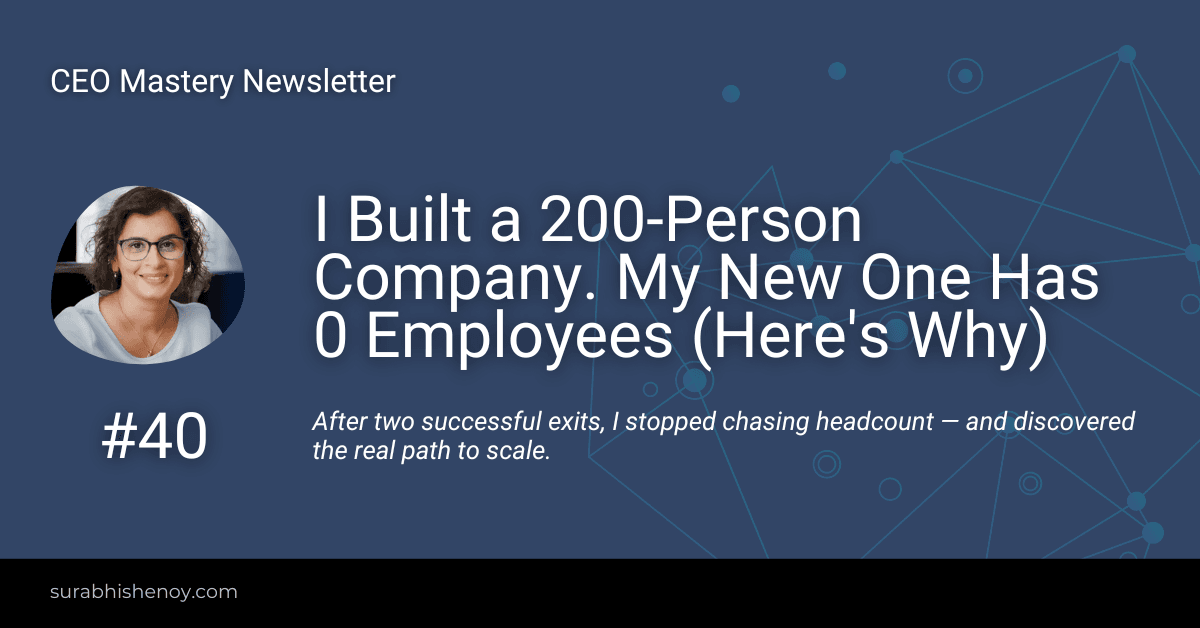What if everything you’ve been taught about scaling a business is backwards?
The Myth: More People = More Success
In my last two companies, I built large teams. One was a 30-person fitness business. The other, a 200-person tech company.
They both scaled well. I exited from both. But they also taught me a critical lesson:
Team size ≠ freedom.
Headcount ≠ scale.
More people = more complexity.
The Reality: Big Teams Created Hidden Costs
That experience showed me that complexity scales faster than revenue.
We had operations managers, client teams, HR — fire-fighting every day. And even though I had “stepped back”… I was still the glue.
I didn’t realize it back then, but every new hire added a hidden operational tax: meetings, decisions, dependencies.
The Pivot: Designing for Money First
After my second exit, I was done chasing headcount as a sign of success.
So when I started this third business — I built it intentionally lean. No payroll. No office. No org charts. Just me. And a few expert freelancers.
But lean didn’t mean casual. I built systems from Day 1 that could scale without me at the center.
My core mission:
To build a high-leverage business that makes money with the smallest operational bloat.
The System: The Lean CEO Model
I am an entrepreneur first, so even though I run a one-person business, I’m still thinking, deciding, and leading like a CEO.
I have:
- A strong revenue engine
- Clear profit levers
- Well-defined systems
- Content-led distribution
- A product ladder that scales
These aren’t buzzwords. Each element is a tool that reduces friction and multiplies outcomes.
That’s what I call the Lean CEO Model.
Most founders believe: “To scale, I need more.”
- More people.
- More projects.
- More pressure.
But I believe: “To scale, you need less — but smarter.”
The Lean CEO isn’t anti-team — it’s pro-design.
It’s not about staying small. It’s about growing intentionally.
It’s built for today’s founder realities (leaner, faster) and today’s opportunities (tech, automation, digital assets).
In 18 months, this model helped me hit profitability faster than any team-heavy company.
I’ve built with teams before. Now I’m building with tech, content, and systems.
The Invitation: Scale Through Leverage, Not Headcount
You could be a 3-person agency, or run a 50-person team…
If growth feels stuck because you can’t find the right people — or you’re tired of people problems — there’s another way.
The solution isn’t to hire more — it’s to reduce your dependency on people. So, instead of expanding your team, I invite you to expand your leverage:
- Redesign your offer so you can charge more and deliver with less effort
- Build delivery systems that run with lean teams
- Create an Operating Model [1], async updates, and ownership metrics that reduce your involvement
Result?
Fewer fires.
Better margins.
More time.
And often — no need to hire at all.

🛠 Tip of the Week: Subtraction Audit
Instead of asking: “What more do I need to grow?”
Try asking: “What can I remove to grow faster?”
Look at your calendar. Your client delivery. Your team structure. Is there a recurring meeting that drains energy? A manual process that can be automated? A role you’re still holding that someone else could own?
Remove one thing this week that adds load but not leverage.
Small deletions = massive clarity.
📚 My Bookshelf:
Actionable insights from books that transformed me and how I built.
Book: Profit First by Mike Michalowicz
“Profit is not an event. Profit is a habit.”
This book challenged everything I knew about business finances. Instead of the traditional formula—Sales minus Expenses equals Profit—Michalowicz proposes: Sales minus Profit equals Expenses.
Implementing this shifted my mindset from reactive to proactive financial management. By allocating profit first, I ensured sustainability and clarity in my operations.
Thank you for being here. We’re just getting started with this new way of thinking.
I’ll see you next Thursday.
To building a high-value, founder-free business,
Surabhi
P.S. Which path are you on? The headcount treadmill or the leverage ladder? Hit reply with “HEADCOUNT” or “LEVERAGE” and let me know your biggest challenge right now. I read and respond to every email.
[1] In this first part of a 3-part series, I share how you can build an Operating Model – a clear system that defines how work flows seamlessly through your growing company. Read it here.
Ready to master your CEO game?
Here are 2 ways I can help
1) Elite CEO Coaching:
Strategic support to scale systematically
→ Book Your Free Clarity Call
2) 1:1 Strategy Session
One focused hour. Clear action plan. Immediate implementation.
→ Get a Power Hour With Me




